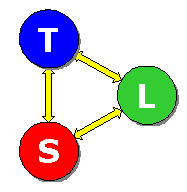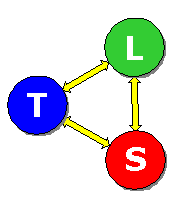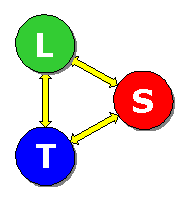Learner, Subject and Teacher (4)
Teacher-Learner-Subject
This is the realm of "personal development" in the mould of a charismatic teacher, at one end of the scale, or of "small talk" at the other. Both this TLS and its LTS counterpart can be the basis of trivial interaction as well as profound forms: in the trivial form the roles of Learner and Teacher can swap rapidly, but the Subject is merely at the whim of the conversationalists (Fig 4). An opinion, once interrupted, for example, is seldom resumed.

Fig 4: Teacher-Learner-Subject (TLS)
In the more profound forms, the Teacher is the fount of all wisdom, and concentrates on the Learner, selecting Subject matter for learning according to the development of the relationship. Although this can be found in groups � and may be the basis of opportunistic teaching within the primary school, for example � its paradigmatic form is an aspect of the parent-child relationship. The content or Subject of the learning is an artefact of the relationship. It may include important things, such as the acquisition of language or looking both ways before you cross the road, but since the Subject is subordinate to the relationship, the truth value of the learned material is highly contingent. The parent, for example, may readily propagate myths which serve her or his interests (and perhaps those of the child), at the cost of the truth about the Subject.
This would seem to be a relatively unimportant pattern within adult education, but closer examination shows that it assumes substantial importance in informal occupational socialisation by "old hands": the development of working myths in the setting of residential care, for example, has been documented by Atherton (1989). With (one hopes) a greater respect for the truth value of the Subject, it is also the pattern of mentoring and professional supervision, in which the mentor/supervisor (Teacher) facilitates the Learner�s learning from experience (see Freeman, 1998, for an excellent account of the process with GPs). When represented visually, the height of the Subject within the sculpt, or its closeness to the Teacher and Learner, can be used to represent the importance attached to its truth value.
Once again, the Teacher has control of the system: she can accept the Learner or not, and may potentially dictate the nature of the Subject, although in this case the institutional context may be embodied in the person of the Teacher (rather than in the Subject in the STL or SLT patterns). Assessment cannot be related to the acquisition of command of the Subject, because that is treated selectively, according to the Teacher�s perceived need for the Learner to learn, and is therefore ultimately subjective. Even more than in the previous TSL case, then, there is a need for the relationship to be regulated by some form of contract (Atherton, 1986).
Learner-Teacher-Subject
This is the pattern of counselling, regarded for present purposes as a special case of learning (Fig 5). Theoretically, the entire exercise is undertaken for the benefit of the Learner, who, as a voluntary client, seeks the assistance of the counsellor (Teacher) to help in the resolution of a problem, which for the sake of the present model, is regarded as being embodied in the Learner. The problem is not the Subject, although coping mechanisms, or re-framing of the problem, may be part of that component. The Subject is artefactual and personal, being whatever new insights or skills the Learner acquires as a product of interaction with the Teacher. Selection is usually the Learner�s choice, most clients of counselling being self-selecting, and indeed employing the counsellor/Teacher. Assessment is solely self-assessment by the Learner, by the criterion of successful resolution of the problem. One problem of counselling and psychotherapy, of course, is that it may create its own agenda or Subject which is at best only peripherally related to the original problem: the clearest example is the phenomenon of transference. While orthodox psychoanalysts may see the management and resolution of the transference as the key to patient progress, it can become an end in itself (Gellner, 1985).

Fig 5: Learner-Teacher-Subject (LTS)
It was suggested above that "theoretically" the encounter is for the benefit of the Learner/client. This was not mere cynicism about counselling, but a recognition that the maintenance of the Learner�s dominance in the relationship is a real problem. Eric Berne (1966), for example, developed the theory of Transactional Analysis at least in part so that it could be taught to patients, who would then feel less "one-down" in the relationship with the therapist, and he similarly insisted on a clear contractual basis for the work. Carl Rogers (1951), the doyen of counselling theorists, also recognised the difficulty of maintaining a non-directive stance in counselling.
Learner-Subject-Teacher
This has already been mentioned as the pattern of research supervision. When sculpted, Learner and Subject are generally in close proximity, but the Learner has dominance because he is inventing the Subject (Fig 6). The Subject is no longer the non-negotiable body of objective truth "out there", but the product of the creative act � however disciplined and rigorous � of the researcher/Learner. The Teacher is a facilitator or resource available on demand. In this example, the Learner/Teacher distinction breaks down, of course. The two actual people concerned may find themselves swapping roles as they contribute different insights to the research process.

Fig 6: Learner-Subject-Teacher (LST)
The roles remain more consistent in the case of adult learning projects as discussed by Tough (1973), initiated by the Learner, primarily for her or his own satisfaction (which means that the Subject is negotiable), and in which a Teacher role (if any) is to move in and out of the overall learning process as required. This LST pattern is basically the one described by contributors to the Boud and Griffin (1987) collection referred to earlier, and uncompromisingly advocated by Jenny Rogers:
"In teaching the customer, not the subject, comes first and is always right, and the customer is the learner" (Rogers, 1989:3)
Using the model
The commonest reaction to the presentation of this model is to say that a given course or programme is "sometimes like this, and sometimes like that". As suggested in the discussion of the first pattern, there are very few programmes which conform simply to one pattern throughout: every teaching and learning enterprise has to move flexibly according to the demands of the task. Nevertheless, there is a basic pattern which applies to each, but is rarely made explicit to all concerned. The sculpt is capable of exposing different assumptions which may never have been articulated in discussion, or may have been obscured by the differing connotations to different participants of terms such as "student-centred", "humanistic" or "traditional". It demonstrates that quite concrete decisions about curriculum, teaching methods and assessment are necessarily implied by the selection of certain patterns � but more to the point it suggests that such decisions, often made for pragmatic institutional reasons, reach into the structure of the teaching and learning encounter and determine the potential patterns and hence values which can be embodied. While some degree of tension between procedures and values can be tolerated, it does make programmes harder to manage and to deliver in a consistent way, and students may be forgiven for confusion and resorting to playing the academic game in a surface learning manner.
Within academic institutions with quality control procedures and consistent policies about, for example, assessment, some of the patterns described above are stable, others much less so. The STL pattern is the current default up to first degree level: attempts to be more adventurous have to contend with its prevalent assumptions, and it may be necessary to recognise that approaches which purport to move the student up the pattern may in the final analysis be tokenistic or even hypocritical.
< 1 2 3 4 5 >
Atherton J S (2013) Doceo; [On-line: UK] retrieved from
Original
material by James Atherton: last up-dated overall 10 February 2013 
This work is licensed under a Creative Commons Attribution-Noncommercial-No Derivative Works 3.0 Unported License.
Search Doceo and associated sites:
![]() Save this on Delicious Tweet
Save this on Delicious Tweet
 Click
here to send to a friend
Click
here to send to a friend
This site is independent and self-funded. The site does not accept advertising or sponsorship (apart from what I am lumbered with on the reports from the site Search facility above), and invitations/proposals/demands will be ignored, as will SEO spam. I am not responsible for the content of any external links; any endorsement is on the basis only of my quixotic judgement. Suggestions for new pages and corrections of errors or reasonable disagreements are of course always welcome.
